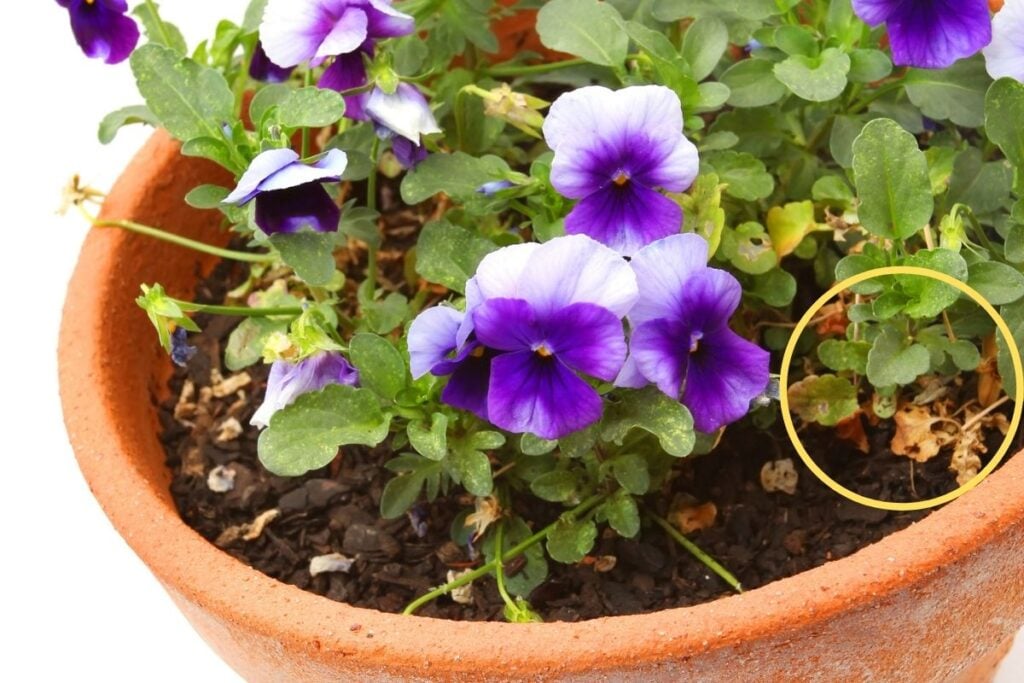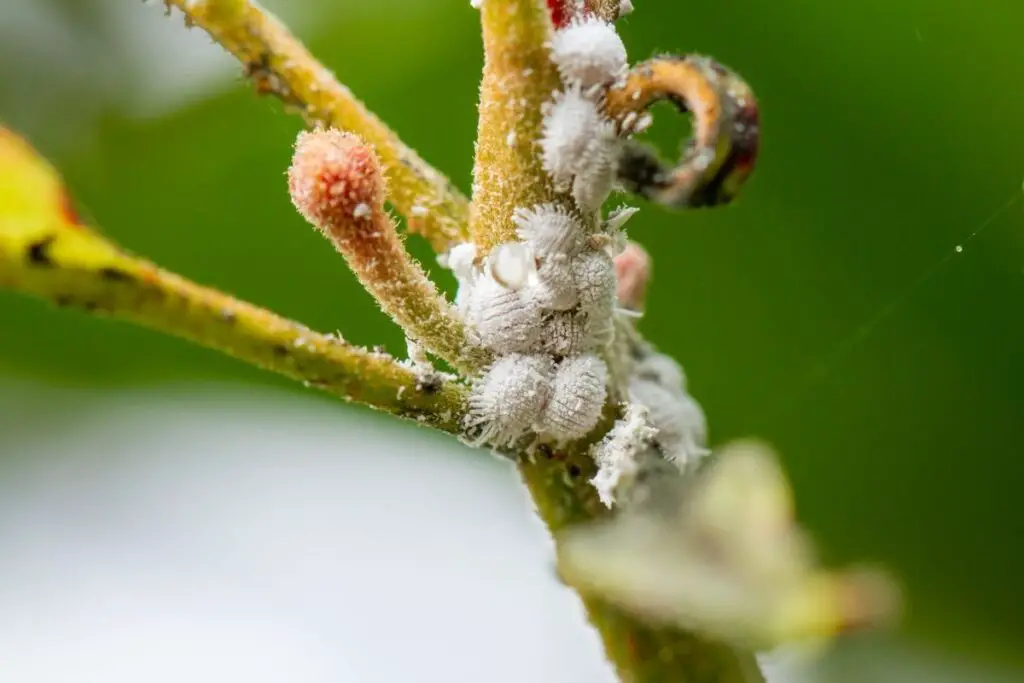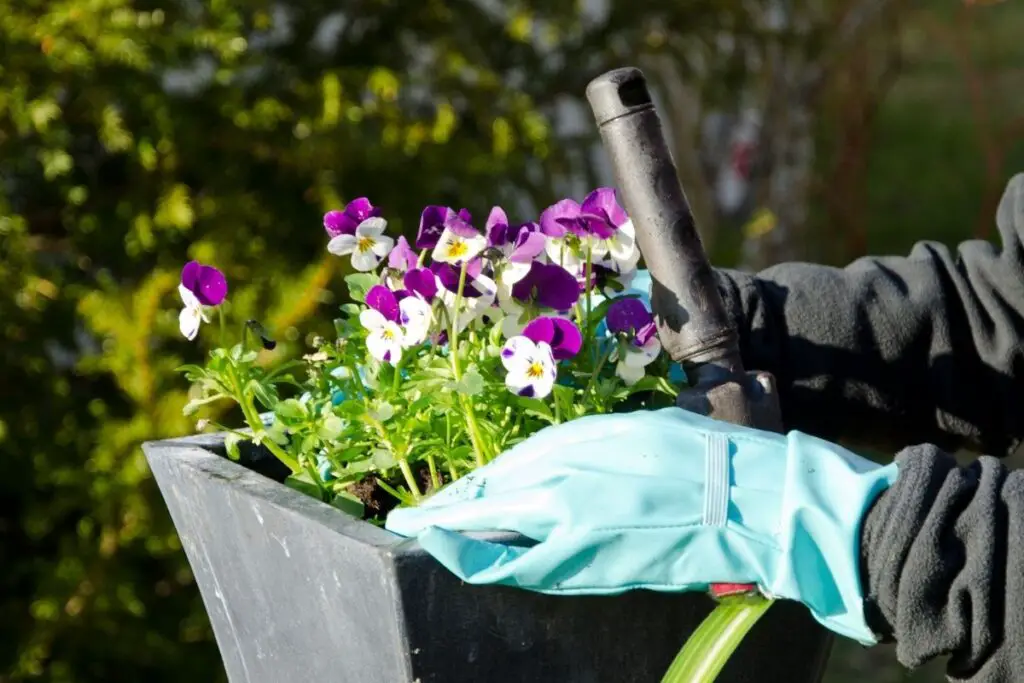Yellowing of leaves or chlorosis is a prevalent problem in all plants. Whenever you see that your pansy leaves change their color from green to yellow, it indicates some problem. Sometimes we fail to discover the real cause behind the yellowing of leaves.
In today’s article, we will be discussing the reasons behind why are your pansy leaves turning yellow.
Overwatering is the primary cause of yellow leaves in pansies. Overwatering often leads to pest infestation and fungal diseases, which causes the pansies leaves to turn yellow. Other problems include improper fertilization, lack of nutrients, and inadequate lighting conditions.
When you grow pansies in your garden, you need to take good care of pansies and fulfill all their requirements to keep them healthy and colorful.
It can be challenging to make the plant recover from such problems if you don’t understand the reason behind the problem. But once you figure out the issue, you’ll be able to revive your pansies in no time.

Why are my pansy leaves turning yellow?
Yellow leaves in your pansies can be due to various issues. Let’s start with the essentials such as water and light, after which we’ll discuss the other problems.
Overwatering
Overwatering can cause a large number of problems in your pansies.
Sometimes, it is confusing to understand how much water these plants need. This is when you mistake overwatering them, and the soil fails to drain the water properly.
That can even lead to root rot in pansies. Root rot causes yellow leaves, wilting, stunted growth, and mushy roots. It also encourages the growth of pathogens born from the soil like Rhizoctonia, Fusarium, and Pythium.
These pathogens cause root rot in the pansies that can eventually kill the plant.
Note: Underwatering can also cause yellow leaves in pansies. Too much dryness will make the leaves pale, yellow, and droopy.
Also read: How Much Water Does A Pansy Need? (Pansy Water Requirements)
Excess sunlight
Pansies grow best when the temperatures are below 78°F.
Excess sunlight will give too much heat to your pansies, due to which the leaves will start fading, resulting in yellow leaves. Ultimately, your pansies will not bloom.
Also read: How Much Sun Do Pansies Need? (Pansies Light Requirements)
Looking for gardening supplies? We have tested 100's of products before recommending them to you guys. Check out our best pick below:
| Image | Gardening Supplies | Best Price? |
|---|---|---|
 Top
Top Top
Top | Raised Garden Bed Kit | Check On Amazon |
 | XLUX Soil Moisture Meter, Plant Water Monitor, Soil Hygrometer Sensor for Gardening, Farming, Indoor and Outdoor Plants, No Batteries Required | No Results |
 Top
Top Top
Top | 82 Pcs Garden Tools Set and Extra Succulent Tools Set | Check On Amazon |
 | Joeys Garden Expandable Garden Hose with 8 Function Hose Nozzle, Lightweight Anti-Kink Flexible Garden Hoses, Extra Strength Fabric with Double Latex Core, (50 FT, Black) | No Results |
 Top
Top Top
Top | Dual Chamber Compost Tumbler | Check On Amazon |
 Top
Top Top
Top | Sunnyglade Plant Stakes | Check On Amazon |
 Top
Top Top
Top | Organic Cold Pressed Neem Seed Oil | Check On Amazon |
 Top
Top Top
Top | Mighty Mint Gallon :-Insect and Pest Control Peppermint Oil | Check On Amazon |
 Top
Top Top
Top | Scotts DiseaseEx Lawn Fungicide | Check On Amazon |
 Top
Top Top
Top | Jacks Classic 20-20-20 All Purpose Fertilizer | Check On Amazon |
 Top
Top Top
Top | 30,000 Seeds Pollinator Attracting Wildflower Mixture | Check On Amazon |
 Top
Top Top
Top | Survival Vegetable Seeds Garden Kit-Over 16,000 Seeds | Check On Amazon |
Insufficient nutrients and improper fertilization
When pansies grow in their natural habitat, they receive all nutrients from nature. But when you grow them in your garden, you must add sufficient nutrients manually for their healthy growth.
Proper fertilization is the only way with which you can provide all the vital nutrients to your pansies. Fertilizers containing nitrogen, phosphorous, potassium, and a few others will boost the growth of the pansies.
Lack of nitrogen will lead to slow and stunted growth, and in advanced conditions, the lower leaves will turn from greenish-purple to yellow (chlorosis). Lack of magnesium also leads to yellowing of the older lower leaves in between the veins.
Also read: Do Pansies Need Fertilizer? (What Type, How Much & More)
Soil acidity
The ideal pH level of the soil that pansies prefer must be between 5.4 to 5.8. A higher or lower pH level will lead to yellowing the leaves in pansies and even cause root rot.
If the soil that pansies are planted in contains a pH level higher than 5.8, it will cause a deficiency of boron and iron.
Boron deficiency will restrict the primary shoot growth. Lack of iron in the soil will result in interveinal chlorosis, yellowing leaves between the veins. This occurs mainly with the younger leaves.
If the soil bed of the pansies contains a pH level lower than 5.4, it will cause magnesium deficiency. The consequence of such deficiency is interveinal chlorosis or yellowing of the fully expanded younger leaves.
Also read: What Type Of Soil Is Best For Growing Pansies? (+Best Soil Mix)
Pest infestation

Pest infestation is another reason for yellow leaves in pansies. Pests like aphids or spider mites are the common insects that feed on the pansy plant.
Aphids: These insects feed by piercing the plant tissue and sucking all the nutrients from the plant. They feed mainly on pansies’ new leaves and stems, causing a nutrition deficiency, resulting in yellow pansy leaves.
Spider mites: These can be seen on the surface of the leaves. You can see fine white web lines on the leaves. They, too, suck the plant sap, resulting in a weak plant with yellow leaves.
Also read: How To Get Rid Of Pests On Pansies? (Bugs Identification+Solution)
Fungal infections
Unfavorable weather conditions and poor watering techniques are common causes of fungal infections in pansies. These fungal infections cause the yellowing of pansy leaves. Let’s see which fungal infections cause yellow leaves in pansies.
Powdery mildew: This is a common fungus detected in almost all plants. This causes white blotches on the foliage and stems and turns the leaves pale and yellow. These can be seen on the leaves whenever the weather gets too dry.
Downy mildew: This makes grey blotches on the leaves and is mainly found on the lower leaves. When the leaves start turning yellow, it means that your pansy is starting to get affected by this fungus. This disease occurs when the weather is cool and damp.
Cercospora leaf spot: This fungal disease starts with purple and black lesions on the lower leaves, and eventually, the leaf color changes to yellow. These yellow leaves start falling off the plant when severely affected. These generally occur when the weather remains warm, wet, and damp during the late spring and fall.
Impatiens necrotic spot virus: This virus can affect the pansies and change the leaves from green to yellow. This virus develops yellow bull’s eyespot and stem and leaf lesions. It makes it difficult for the pansies to survive.
How to fix yellow leaves in the pansy plants?

The first step to treating yellow leaves is to know the right reasons behind them.
We must take care of the plant to prevent the yellow leaves in the pansies.
Before fixing the problem, you must remove the affected leaves from the plant. After that, you can start taking care of them.
No, let us read how to fix the yellow leaf problem in pansies.
Watering technique
Overwatering the pansies is one of the main reasons behind the yellow leaves. Overwatering can cause root rot, making the leaves turn yellow.
Pansies require one inch of water weekly when they are growing actively. Consistent moisture helps to keep the pansy flowers soft and supple. Ease up watering during the rains. While watering regularly, make sure the soil gets dry in between the watering.
You must check the drainage system. If the soil is not draining excess water, that can cause overwatering. You can add two or three inches of compost on the flower bed or add organic mulch over the soil. This will improve the drainage system for the pansies.
During dry and warm summer, water more so that they never lose moisture, and during winter, water a little less.
Fixing the lighting
Pansies need six hours of bright sun daily.
But, during summer, especially in the afternoon, the sun’s heat is too much to tolerate. This can cause sunburn to your pansies. Constant heat will also change the color of the leaves from green to yellow.
To protect your pansies from the excess heat, you can place some big potted plants beside the flower bed of your pansies to prevent the extreme heat from reaching the plants.
But, do not cover them too much, as they will need partial sunlight for growing.
Provide adequate fertilizer and nutrients
When you grow pansies in your garden, the plant is no longer in its natural habitat. You have to give them all the essential nutrients they need for proper growth.
Along with water and light, you need to add sufficient nutrients for their healthy growth. You must fertilize them with suitable fertilizers that contain the crucial nutrients for these plants.
While making the soil mix for the flower bed, we can mix some fertilizer with the soil. But, still, your pansies will need nutrients because, every time we water, the nutrients get washed away from the soil. Giving them fertilizers from time to time will help them absorb the essential nutrients.
Fertilizers containing nitrogen, phosphorous, and potassium are very much favorable for pansies. Nitrogen helps promote the growth of the leaves and cells, phosphorous encourages better root growth, and potassium helps in good water regulation.
Fertilize the pansies every two to three weeks with a little bit of liquid fertilizer to promote root and plant growth.
Fix the soil acidity
Pansies prefer acidic soil. The acidity of the soil should range between pH levels 5.4 to 5.8.
A pH level higher or lower than this range can become a hindrance to the plants. They will fail to absorb proper nutrients and thus have yellow leaves.
If the pH level is higher than 5.8, that will cause a deficiency of boron and iron. To fix this problem, you can use a micronutrient product in your pansy soil bed.
It will help decrease the pH level of the soil and prevent reoccurring such deficiencies. Apply one cup per ten square feet of the bed. Apply this when the leaves are dry. After that, add a good amount of water to the soil.
If the pH level of the pansy soil bed is lower than 5.4, that will result in magnesium deficiency. This mainly happens when the calcium level increases in your soil bed.
You can add Epsom salt to the soil to fix this. Add 1 tbsp of Epsom salt to 1 gallon of water and apply this solution to the soil bed to increase the pH level.
You should check the pH level once or twice a year to ensure that it is suitable for your pansies.
Also read: Is Epsom Salt Good For Pansies? (Know This Before Using)
Treat pest infestation and fungal infections

Pest and fungus attack is common problem behind leaves turning yellow. They suck out all the plant’s nutrients, and it would help if you treat them before it gets too late.
To prevent pest and fungus attacks, keep enough space between the plants for air circulation and avoid overwatering.
First, try an environment-friendly approach to treat the problem. Remove the affected leaves. Water the plants with strong pressure to remove the pests and fungi from the leaves. Do not increase the force as that may damage the plant.
If water fails to remove them, you can use the following products to treat both pests and fungus attacks.
Neem oil: One of the best options to treat pests and fungi. Neem oil exists in concentrate and is a ready-made formula. You can spray this product all over the leaves. Apply the neem oil on the leaves and stems and leave it like that for some time.
Mild insecticide: Insecticidal soap will help to get rid of pests and fungus infections. You can get ready-made insecticidal soap spray bottles or concentrate forms – mix five tablespoons of the insecticidal soap with one gallon of water in a spray bottle.
Mix them well and spray them on the pansies in the morning. Spray them well in the top and bottom of the leaves, stems, and flowers. Let them remain on the leaves and stem for some time and then wash it with water.
Spray the insecticide every four to seven days until the problem gets solved.
Dish soap: You can use dish soap to get rid of pests. But you must avoid highly concentrated or antibacterial soap. Use mild concentrated dish soap.
Mix it with water. Spray the mixture on the leaves, stems, and flowers every four to seven days until the pests and fungus are gone.
You can even use a homemade fungicide, such as mixing one teaspoon of household baking soda and some dish soap with a few cups of water and spraying them in the leaves.
All the above products will help treat the pest and fungus problem, and your leaves will again look fresh and healthy.
Final words
Do not panic if the leaves of your pansy plants are turning yellow.
If you ever see yellow leaves, you must take immediate action. This will help to treat the problem before it gets out of hand.
Yellow leaves on your pansy plants will not turn back to green. So, prune the yellow leaves, and then treat your plant well.
Water the plant only as much as it requires. Keep the soil of the pansy plants moist. Also, ensure that the soil doesn’t hold too much water.
Feed your pansies well so that the leaves don’t turn yellow due to lack of nutrition and energy.
If your pansy plants are attacked by pests or fungus, apply neem oil and get rid of the pesky pests, which can turn the leaves yellow by sucking out the nutrients from your plants.
Ref: The University of Arkansas, Britannica, Utah State University, Wikipedia, The University of Georgia, The Pennsylvania State University, The Royal Horticultural Society.
